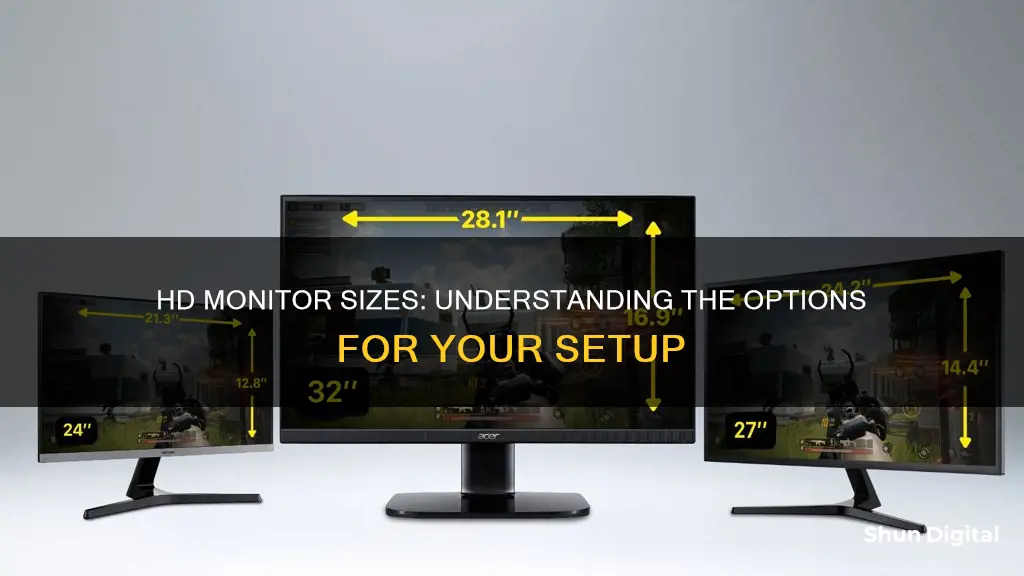
When it comes to choosing a computer monitor, size is an important factor. The size of a monitor is typically measured diagonally in inches, from one corner of the screen to the opposite corner. Standard monitor sizes usually range from 19 to 34 inches, but some ultrawide models can exceed 40 inches. The right monitor size depends on various factors, including intended use, available desk space, and desired specifications.
| Characteristics | Values |
|---|---|
| Screen size | 22, 24, 27, 29, 32, 34, 38, 43, 49 inches |
| Screen size in cm | 56, 61, 69, 74, 81, 86, 96, 112, 125 cm |
| Aspect ratio | 16:9, 16:10, 21:9, 32:9 |
| Resolution | 1080p, 1440p, 4K, 5K, 8K |
| Resolution in pixels | 1920 x 1080, 2560 x 1440, 3840 x 2160, 5120 x 2880, 7680 x 4320 |
| PPI | 54, 81, 88, 108, 163, 326 |
What You'll Learn
- inch monitors are suitable for small desks and business use
- inch monitors are the default size for everyday use
- inch monitors are popular for PC gaming, movies and design
- inch monitors are often ultrawide and used for gaming, movies, design and business
- inch monitors are used for console gaming, movies and design

22-inch monitors are suitable for small desks and business use
22-inch monitors are highly suitable for small desks and business use. They are compact and can fit in limited spaces, making them ideal for small desks and home offices. Their size also makes them more affordable than larger models, and their lower power consumption makes them energy-efficient.
For business use, 22-inch monitors offer a good balance between screen size and desk space. They are perfect for basic computing tasks, such as web browsing, document editing, and casual media consumption. The Full HD (1920 x 1080) resolution provides clear images and text, ensuring a comfortable viewing experience for extended periods. Additionally, 22-inch monitors often come with features such as adaptive sync, low blue light, and tilt adjustability, further enhancing their usability for business purposes.
When choosing a 22-inch monitor for business, consider models like the ViewSonic VX2276-SMH, which offers a sleek design, vivid resolution, and flexible connectivity options. The Samsung Business FT452 Series is another excellent option, featuring a 75Hz refresh rate, IPS panel, and height-adjustable stand. These monitors provide a great mix of features and performance at various price ranges.
It's important to note that while 22-inch monitors are suitable for small desks and basic tasks, individuals working in creative fields such as video editing or graphic design may require larger screens for more detailed work. Additionally, consider the available features, such as resolution, refresh rate, response time, and connectivity options, to ensure the monitor meets your specific business needs.
In summary, 22-inch monitors are an excellent choice for small desks and business use due to their compact size, affordability, energy efficiency, and features tailored for comfortable and productive work experiences.
Monitoring Plex CPU Usage: A Comprehensive Guide
You may want to see also

24-inch monitors are the default size for everyday use
For those seeking a monitor for basic tasks and small spaces, a smaller size may be preferable. 22-inch monitors, for instance, are ideal for student houses, business use, and dual monitor setups. They measure 56cm, making them a good fit for smaller desks while still offering sufficient screen real estate.
On the other hand, larger monitors are preferred for certain specific uses. Gamers often opt for screens ranging from 24 to 27 inches for a more immersive experience, while graphic designers, video editors, and programmers may prefer monitors between 27 and 32 inches for ample workspace. Ultrawide monitors, typically 34 inches or more, are also popular among professionals for multitasking and timeline editing.
When choosing a monitor size, it's essential to consider factors such as available desk space, intended use, resolution requirements, and graphics card capabilities. While larger monitors provide more screen real estate, they may also require more desk space and higher resolutions to maintain image quality. Ultimately, the ideal monitor size depends on finding the right balance between size, resolution, and functionality to meet your specific needs.
Water Usage Monitoring: A Standard Practice in Hotels?
You may want to see also

27-inch monitors are popular for PC gaming, movies and design
27-inch monitors are a popular choice for PC gaming, movies, and design. They offer a good balance between screen real estate and desk space, providing ample space for gaming, graphic design, and image editing. The larger screen size also enhances immersion for gaming and media consumption, making it a preferred option for entertainment enthusiasts.
Benefits of 27-Inch Monitors
27-inch monitors provide a significant amount of screen space, allowing users to have multiple windows open side-by-side for multitasking. This makes them ideal for professionals such as graphic designers, video editors, and programmers who require ample space for their detailed work. The larger screen also enables easier multitasking and side-by-side window arrangements, increasing productivity for those working in fields like video editing or programming.
Technical Considerations
When it comes to resolution, 27-inch monitors typically offer a QHD resolution of 2560 x 1440, which provides sharper images than Full HD. Some 27-inch monitors even support 4K UHD resolution (3840 x 2160), delivering exceptional image quality for those seeking the highest standards. It's worth noting that a higher resolution on a larger screen can display more intricate details in images and videos, enhancing the overall visual experience.
Additionally, 27-inch monitors often come with a range of connectivity options, including HDMI, DisplayPort, and USB-C ports. This versatility allows users to easily connect their laptops or desktop PCs, as well as additional peripherals. The inclusion of USB-C ports is particularly advantageous, as they can provide high power delivery for charging laptops and other devices.
Ergonomics and Aesthetics
The size of 27-inch monitors strikes a balance between providing ample screen real estate and maintaining a comfortable viewing experience. They are large enough to offer an immersive experience for gaming and movies without being overwhelming on your desk. This makes them a good choice for those with limited desk space who still desire a sizeable display. Additionally, many 27-inch monitors feature ergonomic stands that allow for height, tilt, and swivel adjustments, ensuring optimal viewing angles and posture during extended use.
In terms of aesthetics, 27-inch monitors often boast thin bezels, contributing to a sleek and modern appearance. This is especially beneficial for those considering a multi-monitor setup, as thin bezels create a seamless visual experience across multiple screens.
Suitability for Different Users
27-inch monitors are versatile and cater to a wide range of users. For gamers, the size provides an immersive experience without being too large and distracting. The high refresh rates and low response times offered by many 27-inch gaming monitors ensure smooth and responsive gameplay. For movie enthusiasts, the screen size and high resolutions deliver an engaging viewing experience, with some monitors even supporting HDR for enhanced picture quality.
For professionals in design and editing fields, 27-inch monitors offer ample screen space for intricate work while maintaining a comfortable viewing distance. The colour accuracy and resolution of these monitors are crucial factors, ensuring precise and detailed visuals. Additionally, the ability to have multiple windows open simultaneously enhances productivity for tasks like video editing or programming.
Monitoring Memory Usage: A Guide for iMac Users
You may want to see also

29-inch monitors are often ultrawide and used for gaming, movies, design and business
29-inch monitors are often ultrawide, meaning they have a 21:9 aspect ratio. This provides 30% more screen space than a standard 16:9 monitor, making them ideal for gaming, movies, design work, and business use.
Gaming
With their large screens and ultrawide format, 29-inch monitors offer a more immersive gaming experience. The extra screen space allows gamers to see more of their game world at once, and the wider field of view can provide a competitive advantage in multiplayer games. Additionally, the ultrawide format can enhance the visuals of single-player games, making them more immersive.
Movies
For movie enthusiasts, a 29-inch ultrawide monitor can provide a more cinematic experience. Many films are presented in aspect ratios wider than 16:9, so an ultrawide monitor can display them without black bars at the top and bottom of the screen. This gives viewers a fuller picture and a more engaging viewing experience.
Design
In design fields such as graphic design and video editing, a larger screen with a wider aspect ratio can be beneficial. It provides more space for working on projects and allows designers to have multiple windows open side by side, streamlining their workflow. The extra screen real estate can also provide a better overview of detailed projects.
Business
In a business context, a 29-inch ultrawide monitor can enhance productivity by providing more screen space. Users can easily arrange windows side by side, making it easier to multitask and refer to multiple sources of information simultaneously. This can be especially useful for tasks such as data analysis, programming, or financial analysis.
While 29-inch monitors offer these advantages, it's important to consider the available desk space and viewing distance when choosing a monitor size. Ultrawide monitors may not be suitable for small desks, and users should ensure they are sitting at an appropriate distance to avoid eye strain.
Monitoring TempDB Usage: A Guide for SQL Server Admins
You may want to see also

32-inch monitors are used for console gaming, movies and design
Monitors come in a variety of sizes, typically ranging from 19 inches to 34 inches, with some ultrawide models exceeding 40 inches. 32-inch monitors are a great option for console gaming, movies, and design work, offering a balance between screen size and desk space. Here are some key points about using 32-inch monitors in these contexts:
Console Gaming
32-inch monitors provide an immersive gaming experience and offer more screen space for multitasking compared to smaller displays. They often feature a 4K or 1440p resolution and can have HDMI 2.1 bandwidth to take full advantage of modern graphics cards or gaming consoles. Additionally, a fast response time and low input lag are crucial for a responsive gaming experience. Some recommended 32-inch gaming monitors include the Samsung Odyssey OLED G8/G80SD S32DG80 and the LG 32GP850-B/32GP83B-B.
Movies
When it comes to watching movies, a 32-inch monitor can be a great alternative to a TV. It offers a large screen size for an immersive viewing experience. Look for monitors with high resolutions, such as 4K, to ensure crisp and detailed visuals. Some monitors also come with built-in features, like streaming apps, to enhance your movie-watching experience. The Acer Nitro XV282K, for example, is praised for its robust support for 4K resolutions and high frame rate gaming, making it a perfect partner for next-generation consoles.
Design
For graphic design work, a 32-inch monitor strikes a balance between screen size and pixel density. It provides ample space for your design applications and tools while maintaining reasonably high image sharpness. When choosing a 32-inch monitor for design, look for features like colour accuracy, high resolutions, and broad colour space coverage. The BenQ PD3220U, for instance, is a popular choice for graphic design professionals due to its 4K resolution, excellent colour accuracy, and wide range of connectivity options.
Monitoring Bandwidth Usage: Control by Device
You may want to see also
Frequently asked questions
The standard size for HD monitors ranges from 21 to 27 inches. However, with larger screens becoming more affordable, 27-inch monitors are now also considered standard.
Larger monitors offer more screen space, allowing for easier multitasking and side-by-side window arrangements. They also provide a more immersive experience for gaming and media consumption, and can reduce eye strain by allowing users to sit further away from the screen.
Smaller monitors are generally more affordable, space-saving, energy-efficient, and portable. They can also provide sharper images due to a higher pixel density, making them ideal for basic computing tasks, secondary displays, or space-constrained environments.
When choosing the size of your HD monitor, consider your available desk space, your primary use case (e.g., gaming, office work, design), your resolution requirements, and your graphics card capabilities. Additionally, think about the amount of screen space you need, especially if you work in video editing or graphic design.







